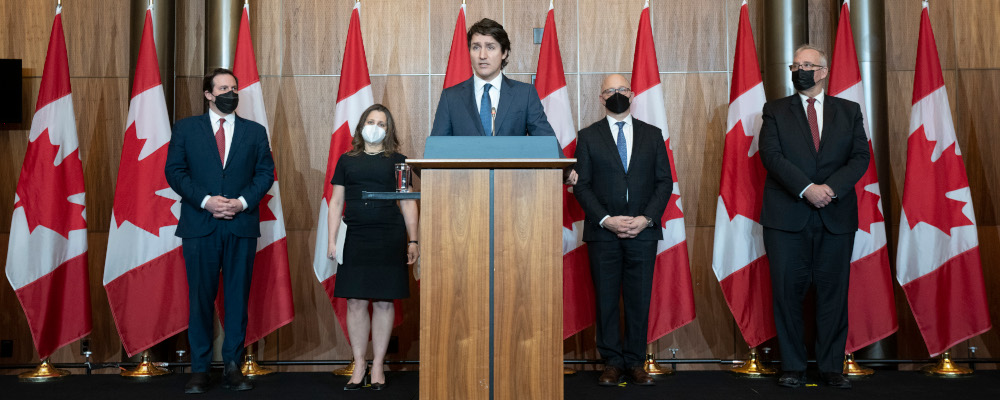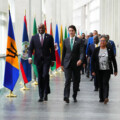The short-lived “national emergency” that Canadians endured in mid-February is already starting to fade in the public consciousness. That is no doubt partly due to the vivid images from Ukraine showing what a truly unqualified national emergency looks like. Yet while it is no longer front of mind, the government’s decision to invoke the Emergencies Act in response to the trucker protests may have an enduring legacy in our public life. One aspect of the government’s response that could have particularly significant implications going forward is the use of “digital jail”, or the freezing of bank accounts and digital assets. The government’s moves to target the assets of those connected to the protests demonstrated both the potency of such measures, as well as the dearth of applicable legal protections.
As Howard Anglin recently emphasized, the effects of freezing someone’s digital assets in our largely cashless society can be far-reaching. Stop and ask yourself what would happen to you if you suddenly lost access to your bank accounts and credit cards. Maybe you have some cash stashed under a floorboard, but probably not. If you are like me, you rely on electronic payment systems for essentially all of your transactions with the outside world. This dependency on modern financial technology has given rise to significant concentrations of power. With a few clicks, governments and banks can take away an individual’s ability to function in society. This kind of digital erasure could amount to a restriction of liberty that is in some ways just as fundamental as a jail sentence.
You might think, then, that important legal protections would exist to prevent the unfair, abusive, or even simply mistaken application of financial sanctions against an individual. Not necessarily. As Jamie Sarkonak pointed out shortly after the emergency was declared, the financial measures initially failed to provide for even the most basic procedural protections for individuals whose assets had been frozen, such as informing affected individuals as to why their account had been targeted and providing a process for disputing frozen accounts.
Could such measures really be consistent with Canada’s Charter of Rights and Freedoms? The answer is a complicated one, largely because of a fundamental gap in the constitutional rights provided for under the Charter. Put simply, the Charter does not protect property rights. Though asset freezes can potentially be challenged on other Charter grounds, they cannot be challenged directly on the basis that they deprive an individual of what belongs to her. And that leaves the door open to potentially abusive or unfair financial measures subject to limited constitutional scrutiny.
While property rights were included in the initial drafts of the Charter put forward by the government of Pierre Trudeau, they were eventually dropped in the negotiation process, apparently due to pressure from some provinces and the federal NDP caucus. The absence of a property rights clause makes the Charter something of an “outlier” among liberal constitutions around the world, according to a leading comparative study of this question. That fact may become increasingly significant if governments continue to wield the powerful financial tools that modern technology has put at their disposal. The regulations enacted under the Emergencies Act have since been revoked, but in an era of increasing polarization and disaffection, it likely will not be long before a government is again tempted to resort to such extraordinary measures in response to social unrest. The absence of property rights protections from our Charter—previously an interesting quirk—may become an increasingly salient feature of our system of government.
Outright acts of government confiscation have historically been quite rare in Canada. However, the absence of constitutional protections for property rights has sometimes allowed for egregious abuses of government power. The case of Authorson v. Canada provides an illustrative example. For decades, the federal government held pension funds on behalf of disabled military veterans without crediting those funds with any interest. This gave rise to a straightforward financial liability to the veterans based on existing law. Rather than pay what it owed, the government of Brian Mulroney passed legislation immunizing itself against any claims by the veterans. Because of the absence of property rights protections under the Charter, there was no way to challenge this law on constitutional grounds. The veterans attempted to rely instead on the 1960 Canadian Bill of Rights, which is ordinary federal legislation and not part of the Constitution. Unfortunately, the Supreme Court of Canada gave a narrow reading of the property rights protections under the Bill of Rights and the government’s confiscatory law was upheld.
What does all this mean for financial measures like those enacted under the Emergencies Act? Well, to be blunt, if the government can pass legislation to take money from disabled military veterans, then it can probably do the same to less sympathetic groups. That does not mean there are no restrictions at all. Property rights are not directly protected under the Charter, but a deprivation of property can still indirectly infringe another Charter right. For instance, freezing someone’s assets based on their choice to support a political cause might give rise to a Charter claim based on the section 2(b) right to freedom of expression, but the focus of the inquiry would be on expressive activity, not property per se. As long as the limit on expressive activity is found to be reasonable, even ruinous effects on property interests could be upheld.
Other Charter rights could conceivably be given a broad interpretation that would protect property rights. However, courts have been wary of any interpretation that would bring property rights into the Charter through the back door. It is generally accepted, for instance, that liberty under section 7 does not include the freedom to hold property, and that the section 8 right against unreasonable search or seizure protects privacy, not property. Accordingly, if property rights are to be added to the Charter, it will most likely have to be done through a formal constitutional amendment, rather than through the judicial interpretation of existing rights.
There may be legitimate doubts as to whether a constitutional amendment adding property rights to the Constitution is necessary or wise. For one thing, property rights in Canada are protected by a constitutional tradition that is much older than the Charter. That tradition, which can be traced back at least to the time of John Locke, is based on a combination of common law protections and Parliamentary supremacy. Although Parliament has the ultimate power to infringe property rights by enacting clear legislation to that effect, it is expected that it will do so only to the extent that it finds such infringements to be truly justified. For most of Canada’s history, that system has worked reasonably well. However, it relies on Parliamentarians to act as vigilant guardians of the rights of the citizenry. It remains to be seen if legislators are up to that task in an era when governments will increasingly be tempted to use digital jail as a means of social control.
It may be, then, that the spectre of digital jail will eventually prompt renewed calls for the inclusion of property rights in the Charter. On the one hand, such a move would address a fundamental gap in our system of constitutional rights, a gap that sets Canada apart from many other liberal democracies. On the other hand, though, it would further constitutionalize our politics, shifting another set of decisions from elected legislators to unelected judges.
A property rights amendment to the Constitution seems unlikely in the short term, given the high level of national consensus that would be required. But there is nothing to stop Parliament (or provincial legislatures) from enacting ordinary legislation to provide protection against the unfair use of asset freezes and other restrictions on property rights. The Canadian Bill of Rights would be a good place to start. Recall that it is ordinary federal legislation, subject to amendment by Parliament. The Bill of Rights could easily be amended to bolster the protections for property rights that proved inadequate in the Authorson case. Reinforcing the Bill of Rights would demonstrate that Parliament takes seriously its traditional role in upholding the rights of the people. Digital jail is a relatively new problem, but it could potentially be solved in old ways, by recourse to an ancient rights tradition that long predates the Charter.
Recommended for You

Ginny Roth: J.D. Vance, Pierre Poilievre, and how they slice their economic pie

David Polansky: As President Biden leaves the race, will the Democratic Party hodgepodge hold?

RCMP spending to protect MPs may have risen 112% since 2018, as Canadian politicians face greater rise in threats

Trevor Tombe: Canadians are paying billions in hidden taxes on new homes








